large number of small
magplanes, at much higher speeds, with all stations off-line and served with
skip-stop (express) service. All magplanes would be under the control of a
central computer system, and headways as short as 20 sec are thought to be
feasible. Clearly, this type of operation is similar to an airport where one
typically can see 50 or more operations per hour. Such a system will be
referred to as a small magplane system (SMS).
Component 3-Magstation Location, Number, and Access System
Design
In the U.S. high-speed studies that have been conducted,
the investigators have used the conventional assumption that the stations
would be few and far between. As shown in Figure 3, the system's average
speed will decline as the number of stations is increased, so there is a
desire on the part of the system operator to keep the number of stations to
a minimum. This is even more true for a maglev system, where cruise speeds
of 483 kph (300 mph) are frequently cited as desirable. At these speeds, the
minimum station spacing must be large if the train must stop at every
station. For example, if one assumes a reasonably comfortable acceleration
of 0.15 g (gravitational pull) and deceleration of 0.2 g and if the average
speed is to be at least 90 percent of the cruise speed, then for a cruise
speed of 100 m/sec (224 mph) the mean interstation distance should be at
least 57 km (35 mi) (2). For the higher cruise speeds and the even lower g
factors believed necessary by some, the mean interstation distance would
have to be even greater.
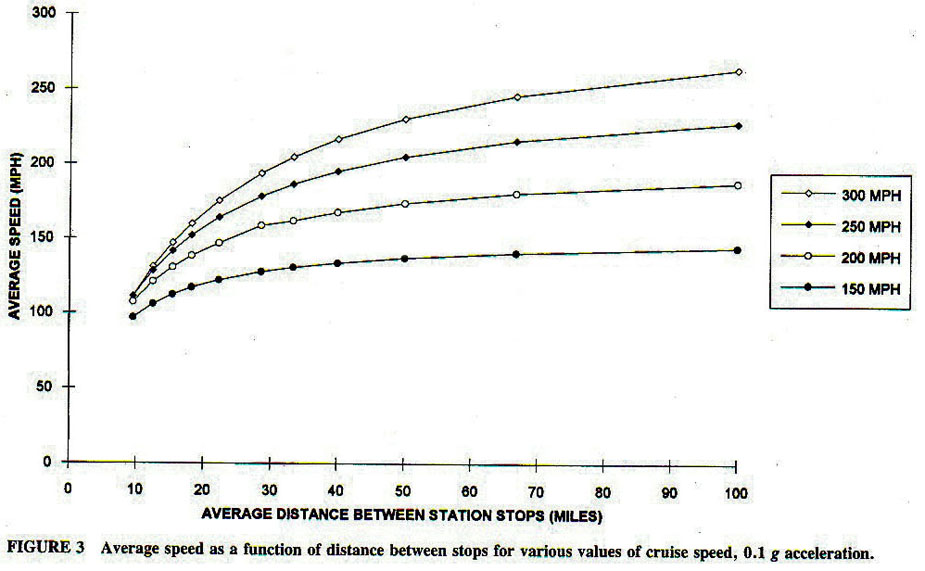
Since high cruise speeds are often cited as being
required to be competitive, the mean distance between stops might have to be
at least 80 km (50 mi) or more for any maglev system. However, if all
stations are off-line, the station spacing can be less than 80 km (50 mi) if
desired. This mode of operation would still allow high average system speeds
even though the number of stops made by each magplane at the system's
magstations would be limited.
GENERAL MAGSTATION LOCATION AND DESIGN ISSUES FOR EN ROUTE
STATIONS
What are the implications of the SMS concept for the
physical design and layout of the stations? First, assume that it will be
possible and desirable to design all maglev stations as off-line, so that
magplanes can whoosh through (or by) them at high speed [402 to 483 kph (250
to 300 mph)]. A key technical issue is the type of switch used to allow the
magplane to move from the mainline magway to the off-line magway. If a
lowspeed switch is used, the off-line stations could have a compact layout.
High-speed switching would require a much longer off-line magway. Figure 4
shows these two possibilities for an en route magstation layout.

Most of the en route stations would not have to be very
large, because there would be many of them and each would serve a relatively
small geographic area. Figure 5 compares a conventional and a magplane
route/station layout for a hypothetical corridor, initially and in the
future. The high-speed line connects two major cities but also provides
service to other cities in the corridor. Clearly, one needs to determine
what access standards and urban growth policies are desired to guide the
design of the system. Long-term issues are involved, as illustrated by the
different patterns of growth that may evolve, influenced in part by the
number and location of the stations that are provided. Magstation spacing
decisions should be related to the present and desired future urban
development pattern, and they will vary greatly in different regions of the
United States.

It is, of course, very difficult to get a "region" to
define "its" goals with respect to a regional growth pattern. Few regional
groups in the United States are capable of accomplishing such a task. A
published paper provides a more detailed discussion of the problems of
selecting and evaluating the number and location of stations in an urban
corridor (5).
Smaller stations would be easier to locate in highly
urbanized regions, because they will be perceived to have a smaller negative
impact on the surrounding community, especially in terms of the traffic
congestion, noise, and air pollution. This is a factor of great importance
to private developers, who need to minimize the delay that often precedes
approval for development projects. However, if a large-scale development is
planned around the magstation, this "rapid approval" benefit might not be
realized. Several recent studies provide considerable evidence, from the
United States and abroad, of the opportunities and pitfalls in this area
(6-9).
Another factor (negative to some, positive to others) is that if many
stations are built, some would probably be located in urban fringe or
largely rural areas. Such locations might stimulate a more dispersed urban
development pattern than might otherwise occur. To some this means more
urban sprawl and its associated large infrastructure costs and environmental
degradation (10-12). Others will think only of the likely increase in land
prices that would occur.
Providing numerous stations would generate a higher level
of conflict between those who favor compact urban development patterns and
those who believe that affordable housing objectives and new compact
communities (13) could be served by such stations. Providing parking spaces
at these smaller stations would be easier, because fewer spaces would be
required and the impact on the surrounding community would be less. But it
would be more difficult to make these stations into full-fledged intermodal
ground transportation hubs. This is because the volume of passengers needing
such services would be too low in many cases to make the provision of
conventional transit services economically feasible.
It is much more likely that vehicular connecting modes
would be of a "dial-a-ride" type, or small buses, vans, and taxis. Such
modes probably could provide a level of transit service that is appropriate
to the relatively low demand at the magstation, assuming that several
hundred parking spaces are provided adjacent to it. If parking is not
provided, more extensive transit services might be possible and necessary.
The preceding discussion has considered only en route
stations. An SMS would generate two other system design problems. One has to
do with the design of a stub magstation one that is at the end of a route,
probably in a central city location. Typically, these stations have been
designed to accommodate a few long trains, and they have a long and linear
shape. This type of layout will not work well for a large number of small
magplanes that arrive and depart at frequent intervals. It may not be
feasible to remodel most of the old central city stub stations so that they
could accommodate a large number of magplanes.
A physical layout more like that of an airline terminal
would probably be needed (14). Figure 6 shows what such a stub terminal
might look like. It was assumed in Figure 6 that the magplanes could
negotiate a loop configuration to reverse their direction of travel. Figure
7 shows a similar loop-type layout for a magstation located adjacent to an
urban rail station at a suburban intermodal hub. Figure 8 shows a similar
layout except that a turntable is used to enable the magplanes to reverse
direction. Figure 8 also shows four magways beyond the turntable that could
be used to store reserve magplanes. This type of storage area would be
needed at several locations to help deal with peak demand and directional
imbalance problems as they arise.
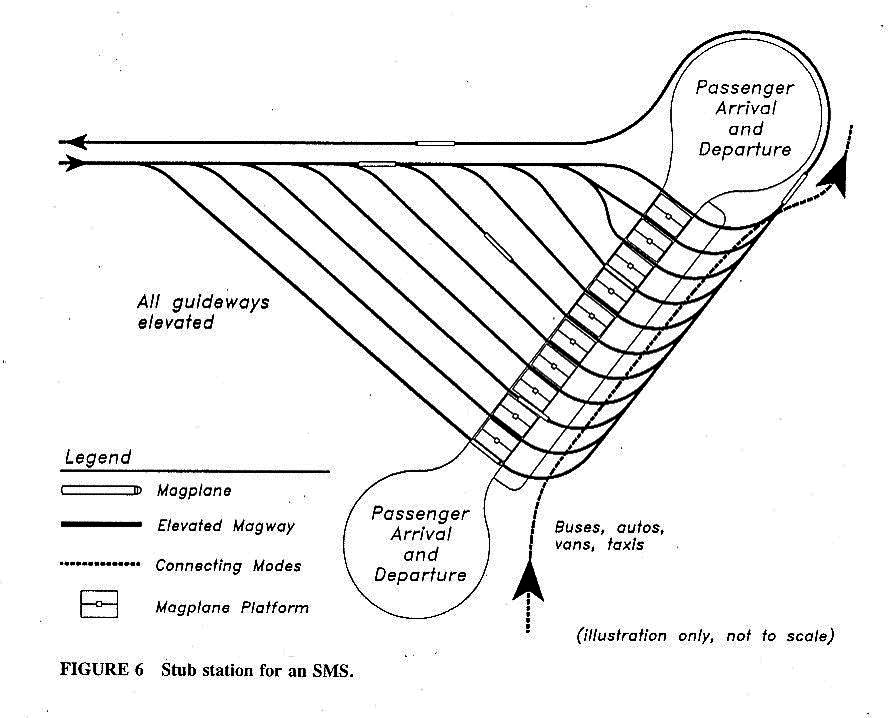
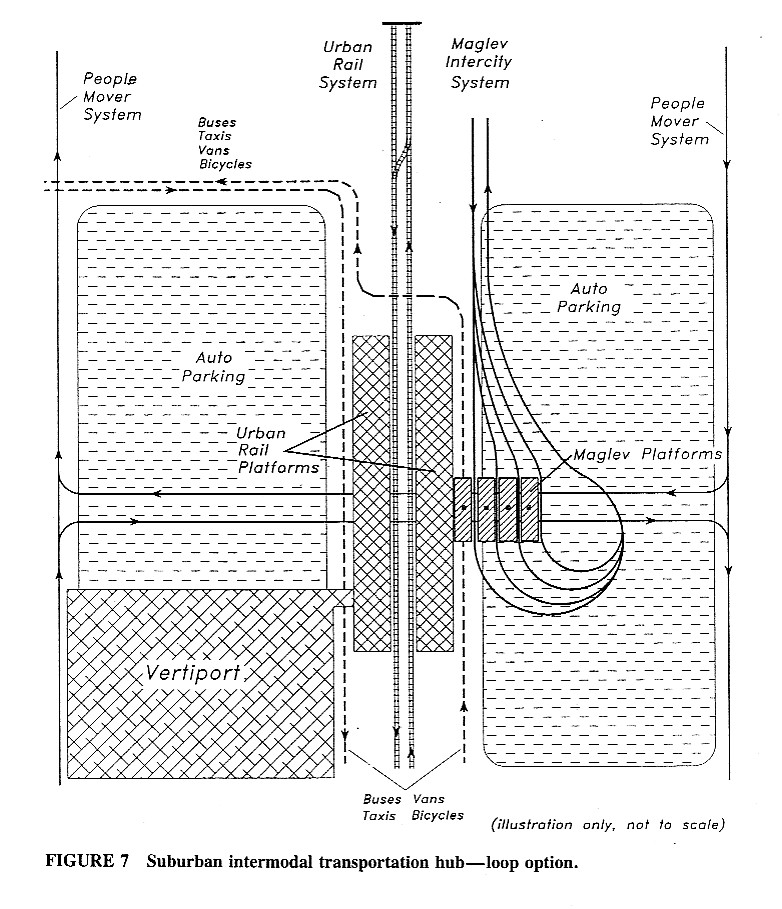
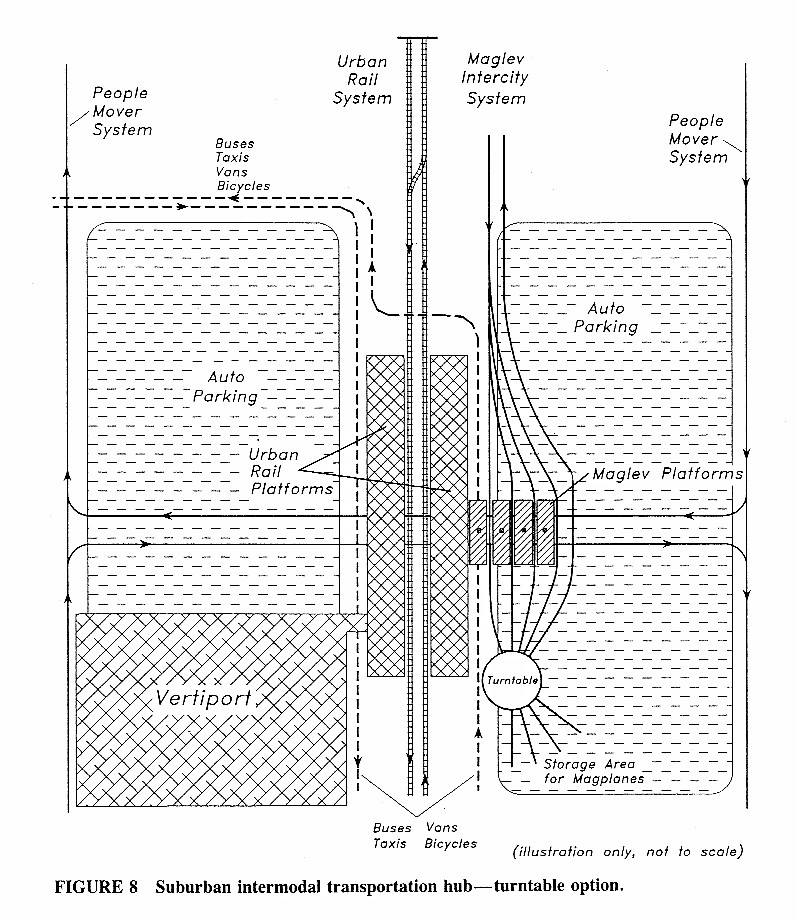
SPECIFIC MAGSTATION DESIGN ISSUES
A major factor in the design of magstations would be to ensure that the
high-speed magplanes could whoosh through or by the magstation at up to 483
kph (300 mph) safely and without causing discomfort to people waiting at the
magstation. This might require that the magstation be located at some
distance from the mainline magway or that special techniques be used
to reduce the noise, vibration, and wind/pressure effects of a high-speed
"flyby" to satisfactory levels. Considerable noise/ vibration insulation
treatment of the magstation buildings might be required. Special
consideration would also have to be given to the situation where trains
moving at high speed in opposite directions pass each other at or near the
magstation. Some type of enclosure, like a glass wall or other barrier
between passengers and magplanes, might be needed at the
magstation to ensure that noise, vibration, and wind levels are maintained
at satisfactory levels.
Clearly, a considerable length of off-line magway will be
needed to provide for the deceleration and acceleration needs of a magplane.
Many believe that a magplane probably cannot be switched to an off-line
magway at speeds greater than 241 kph (150 mph). Using this assumption, a
magplane would have to decelerate from about 241 kph (150 mph) at the
off-line magway switch to a stop at the magstation. If the deceleration rate
over the braking distance was 0.2 g, the deceleration segment of the
off-line magway would have to be about 2 km (1.2 mi) in length. Adding an
acceleration magway of the same length would make the length of one side of
the off-line magway about 4 km (2.4 mi) or 8 km in total. If this magway is
assumed to cost about $10.6 million per km ($17 million per mi) (2), the
off-line magway for such a magstation would cost about $82 million. If the
cost of buildings and associated facilities is added to this figure, an en
route magstation cost of around $100 million might result. Of course, if the
magplane speed were reduced significantly before switching to the off-line
magway, the cost could be reduced significantly-but so would the average
speed of the SMS. Still, the time required for deceleration probably
would not impact the overall average speed of the service provided greatly
and the importance of this minor delay would be well compensated by the
higher level of service that could be provided.
Other options have been suggested that involve using the
same section of magway for both deceleration and acceleration. William
Aitkenhead of Magneplane, International, has devised several such concepts
(see Figures 9 and 10). In Figure 9, the length of off-line magway needed
could be reduced at the cost of some additional switches, overpass
construction, and some additional control problems on the bidirectional
magways. Aitkenhead has also suggested that the bidirectional magway concept
be applied to the design of way-off-line magstations (see Figure 10). In
Figures 9 and 10 it has been assumed that each magstation would have a
turntable to reverse the direction of the magplane. If these way-off-line
magstations were not served more than a few times each day, considerable
savings in magway cost could be achieved by using a bidirectional magway.
But some additional switches would be required and the control problem would
become a little more complicated. In all cases, these trade-offs need
further investigation.
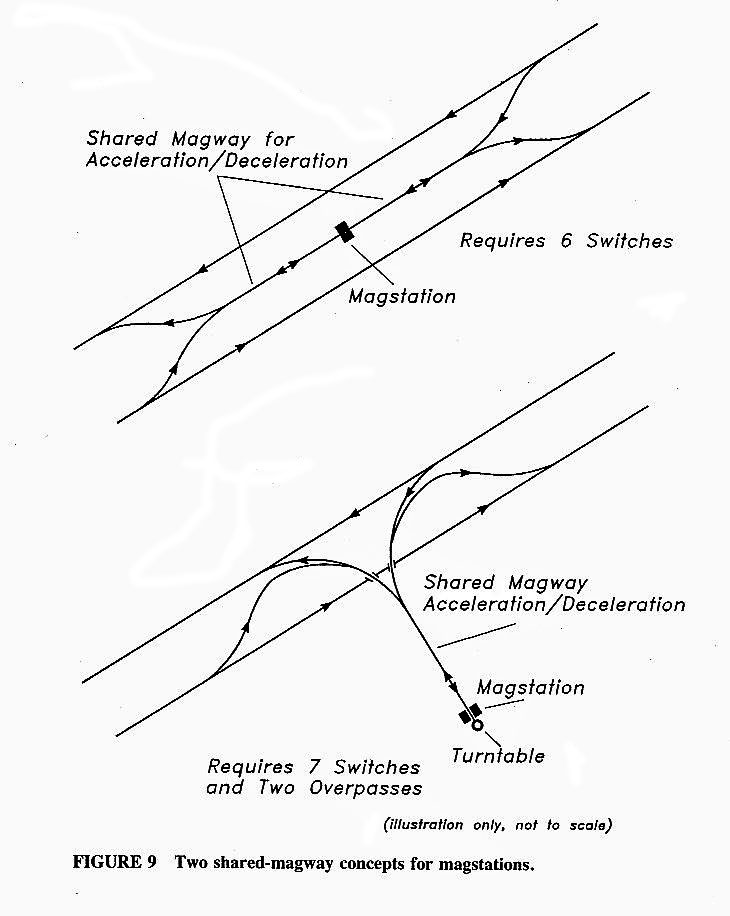
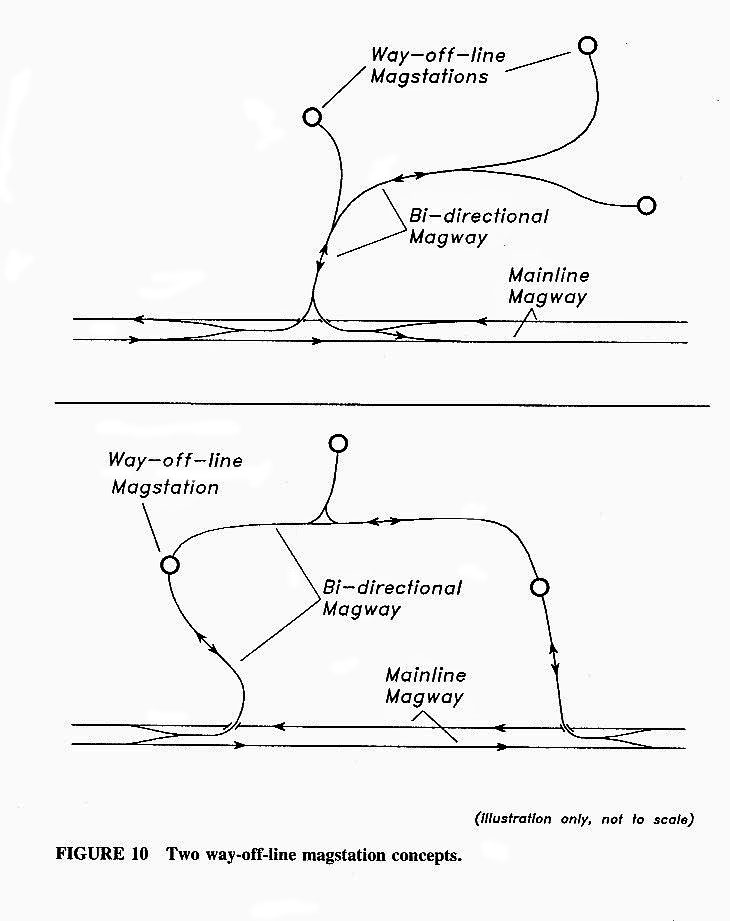
COMPETITIVE POSITION CONSIDERATIONS
The preceding discussion highlights the significant trade-off between the
maximum switching speed and the cost (and therefore feasible number) of the
stations. The use of highspeed switching implies that a magstation might
cost as much as $100 million. At such a price there would be a strong
tendency to minimize the number of stations provided-and therefore the
access ease. Ultimately, important trade-offs will have to be made between
the spatial extent of system access (and associated door-to-door travel
times and costs), average system speeds, and total capital cost. This
three-way trade-off is complex. Two essential questions are, How important
is system access (i.e., door-to-door travel times and costs) relative to
average system speed and capital/operating costs? How important is system
access to the competitive position of the maglev mode?
For example, the mainline magway cost of a 300-mi maglev
system would be about $5.1 billion, at $17 million per mi. If such a system
had stations every 30 mi (a total of 11 stations, 2 stubs and 9 en route)
and used a high-speed switch, the magstation cost (at $100 million per
magstation) would be about $1.1 billion. This is a little more than 20
percent of the mainline magway cost. Use of a lower-speed switch would
reduce the magstation cost substantially but might also reduce the average
system speed considerably and complicate the operational control problem.
Clearly, the likely savings in door-to-door travel times and
costs must be examined before any rational approach to dealing with these
trade-offs can be defined. One such attempt was made recently in a study of
the potential market for a civil tiltrotor system (15). In this study,
comparative estimates of door-to-door travel times via conventional air and
civil tiltrotor were developed for the Northeast Corridor of the United
States. Twelve vertiport locations were assumed (6 in New York, 3 in Boston,
2 in Washington, and 1 in Philadelphia). Assumed schedules were then
evaluated with the Boeing Market Share Model, a proprietary simulation model
used for fleet planning.
The result was that an average trip via a conventional fixedwing aircraft
would take 3.2 hr, whereas a civil tiltrotor trip would require only 1.9 hr,
a 1.3-hr savings (or a 41 percent reduction). The average flight times were
almost identical, so all of the travel time savings were due to reductions
in ground access, terminal waiting, and taxi out/in times. Figure 11 shows
these results. These findings cannot be extended too far, but they suggest
that an SMS with 12 or more stations in the Northeast Corridor could be
competitive with conventional air travel because it would allow deep cuts in
ground access
and terminal times. Together, these two times were estimated to require
about 80 percent of a 3.2-hr door-to-door travel time by the Boeing Market
Share Model.
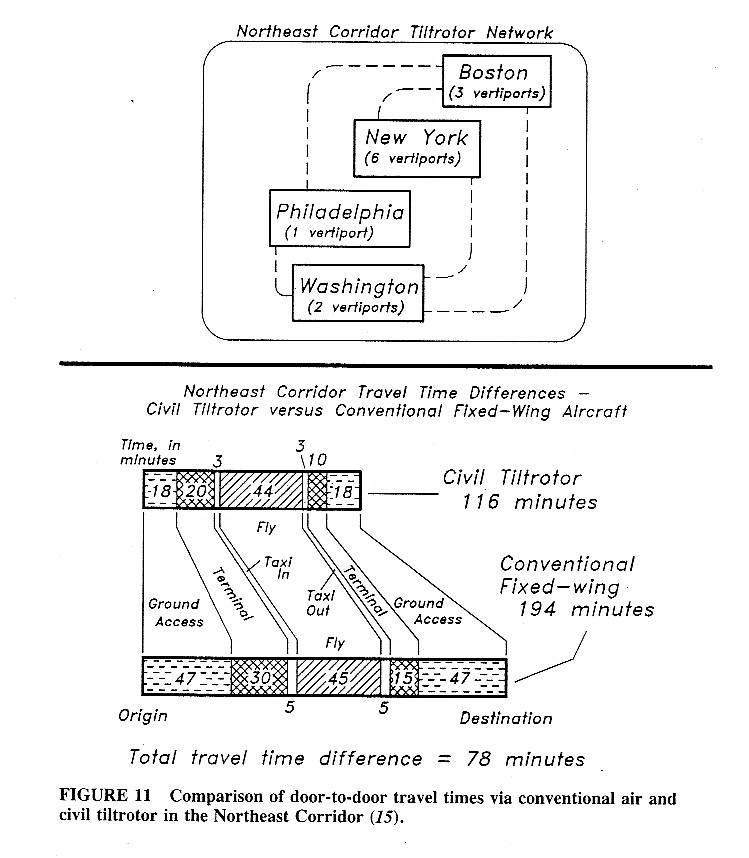
Of course, 12 vertiports might be able to provide shorter
average ground access times than could 12 maglev stations, because they
would not have to conform to a linear configuration. Given the very
dispersed urban form in most U.S. metropolitan areas, linear systems cannot
provide access levels as good as those not so constrained. For example,
conventional wisdom suggests that if a transportation system takes you
directly to the downtown of the metropolitan area, it will serve most of the
important destinations in the metropolitan area. This is a common
misperception. Few U.S downtowns contain more than 20 percent of all the
employed persons in a metropolitan area. The other 80 percent are spread
widely in small- to medium-sized clusters or commercial strip developments,
mostly in suburban areas. This means that a linear system that provides
service to the downtown as a primary objective will neglect many important
destinations, which require substantial time and effort to reach from a
downtown location.
Finally, any assessment of the cost of the components of
a maglev system and its competitive position must include how it is to be
financed. If public funds were used to pay for all of the stations and
private funds were used for all other components of the system, the type and
number of stations provided would be determined by a political process
conducted at a regional or multistate level with considerable input from the
federal government. The physical design of such a system (routes and
stations) will be strongly influenced by the way in which private and public
funds are commingled to generate the large investments needed to build and
operate the system.
GROWTH CONTROL CONSIDERATIONS
If developers can be found that own or can acquire large parcels of land
in locations suitable for stations and if they are willing and able to
undertake large-scale development projects that include an integrated SMS
magstation, both the developer and the SMS owner (and perhaps the public)
could benefit. Such an arrangement generally falls under the heading of
joint development and is often cited as a synergistic opportunity that could
arise from the deployment of a maglev system. Joint development offers a
means of cost sharing and the possibility of a fairly large built-in
clientele for the maglev system. The essential idea is that such
megaprojects would be like "pearls on a string," with the maglev line the
link that ties them together.
An adverse impact, in the minds of many persons, would be
the tendency of an SMS to encourage a further rapid development of
relatively inexpensive land in urban fringe and semirural areas. Whereas
some such developments might be viewed as desirable by nearly everyone and
permitted, others might be considered to be undesirable. They could only be
prohibited by strong growth controls and regulations in those areas where
they would generate major damage to the ecosystem or require large public
expenditures for new infrastructure. At present, only a few states have
reasonably strong growth management laws in place (e.g., Oregon, Washington,
Florida, New Jersey, and Vermont).
It is not clear that the states that have enacted growth
management laws could handle the land use impacts of an SMS without some amendments to their current growth
management laws. SMS can provide major increases in accessibility in certain
locations, and such a technology was not even contemplated at the time this
legislation was formulated and passed. An important part of any national
maglev program would be to encourage (or require) the affected states to
enact appropriate land use legislation for dealing with the growth inducing
accessibility impacts of the new system.
CONCLUSIONS
Current thinking about a second-generation U.S. maglev technology
suggests that it would use many small magplanes, skip-stop service to
off-line and way-off-line stations, and very frequent service. This means
that the design of its access facilities can be radically different from
European practice and conventional thinking among U.S. practitioners. In
short, a high-speed maglev system that uses small magplanes to serve many
stations would provide access times far superior to those provided by
conventional airports, whose difficult access problems are likely to grow
worse.
This might make an SMS competitive with air travel
because its ground access and terminal times might (conservatively) be less
than half those of congested airports. Access time savings could, in some
cases, make door-to-door travel times equal to or less than those provided
by the airlines. Moreover, if the maglev system had high reliability and
delays were virtually nonexistent, further time savings over air travel
could be realized. If the maglev fare were equal to or less than air fare
and all other factors were comparable, SMS passenger volumes might be
significantly higher than those currently forecast for conventional
high-speed, long-train systems that provide only a few stations.
The system benefits derived from these SMS attributes are
significant and should encourage those who hope to develop and deploy such
systems. However, two major adverse effects could occur. A successful maglev
system could divert many more persons from the air travel sector than is now
thought to be likely (16), and the airlines might oppose the deployment of
an, SMS. Or they might decide to participate in the financing, ownership,
and operation of the SMS. Companies, like Boeing, that manufacture aircraft
could decide to manufacture magplanes, making use of their extensive
aircraft fuselage design and manufacturing knowledge and experience.
The larger implications derived in this paper indicate the need to
broaden the scope of future maglev studies. A systems analysis approach that
includes system access as a major variable is needed to make any maglev
system investment proposals credible. Before any maglev system can be
justified, its proper role in relation to existing and expected intercity
travel options must be defined. Our governments should not allow a
"stand-alone" maglev system to be built. Analyses of future intercity
options should also include tiltrotor-type aircraft and their associated
vertiports as a possible competitive intercity mode (17). A high priority
should be given to finding ways to integrate vertiports, urban rail transit,
maglev systems, and connecting ground modes in the form of intermodal
stations.
REFERENCES
1. Special Report 223: In Pursuit of Speed: New Options
for Intercity Passenger Transport. TRB, National Research Council,
Washington, D.C., 1991.
2. Benefits of Magnetically Levitated High-Speed
Transportation for the United States. Volume 2-Technical Report. U.S.
Senate Committee on Environment and Public Works, 1992.
3. New York State Technical and Economic Maglev
Evaluation: Final Report. Energy Authority Report 91-5. New York State
Energy Research and Development Authority, 1991.
4. W. Streeter. The French Train a Grande Vitesse:
Focusing on the TGV-Atlantique. Working Paper 558. Institute of Urban
and Regional Development, University of California at Berkeley, Berkeley,
1992.
5. J. B. Schneider. Selecting and Evaluating the Number
and Locations of Stations for an Intercity High Speed Ground
Transportation Corridor in the U.S. Transportation Quarterly, 47:2,
April, 1993, pp 221-245.
6. J. G. Allen. Public-Private Joint Development at
Rapid Transit Stations. Transportation Quarterly, Vol. 40, No. 3,
1986, pp. 317331.
7. R. Cervero, P. Hall, and J. Landis. Transit Joint
Development in the United States. Institute of Urban and Regional
Development, University of California, Berkeley, 1991.
8. B. Sands. The Development Effects of High-Speed
Rail Stations and Implications for California. Department of City and
Regional Planning, University of California at Berkeley, Berkeley, 1992.
9. E. J. Boldin.~Taiwan HSR Joint Development
Methodology: A Case Study. Presented at the 71st Annual Meeting of the
Transportation Research Board, Washington, D.C., 1992.
10. A. Bonnafous. The Regional Impact of the TGV.
Transportation, Vol. 14, No. 2, 1987, pp. 127-137.
11. M. Houee. The Relations Between High Speed Trains
and the Organization of Regional Transport Services. Journal of
Advanced Transportation, Vol. 20, No. 2, 1986, pp. 107-132.
12. D. L. Roth. The TGV System: A Technical,
Commercial, Financial and Socio-Economic Renaissance of the Rail Mode.
Department of Systems, University of Pennsylvania, Philadelphia, 1990.
13. D. Kelbaugh (ed.). The Pedestrian Pocket: A New
Suburban Design Strategy. Princeton Architectural Press, New York,
1989.
14. W. Hart. The Airport Passenger Terminal. Wiley-Interscience,
New York, 1985.
15. P. Thompson et al. Civil Tiltrotor Missions and Applications,
Phase II: The Commercial Passenger Market, Final Summary Report. NASA
Report CR 177526. NASA and FAA, 1991.
16. K. Buckeye. Implications of High Speed Rail Alternatives on Air
Traffic in the Minneapolis-St. Paul to Madison, Milwaukee and Chicago
Corridor. Presented at the 71st Annual Meeting of the Transportation
Research Board, Washington, D.C., 1992.
17. New Ways: Tiltrotor Aircraft and Magnetically Levitated Vehicles.
OTA-SET-507. Office of Technology Assessment,
U.S. Congress, 1991.
Additional detail on this general topic is available in an
extensive NMI Report entitled
Selecting
and Evaluating the Number and Location of Stations for an Intercity
High Speed Transportation Corridor in the U.S.
 Also,
see the Maglev2004 conference paper that describes the technical
attributes of the Magplane technology in more detail.
Also,
see the Maglev2004 conference paper that describes the technical
attributes of the Magplane technology in more detail.
Publication of this paper in the Transportation Research
Record was sponsored by TRB Committee on Guided
Intercity Passenger Transportation.

Last modified:
March 01, 2006
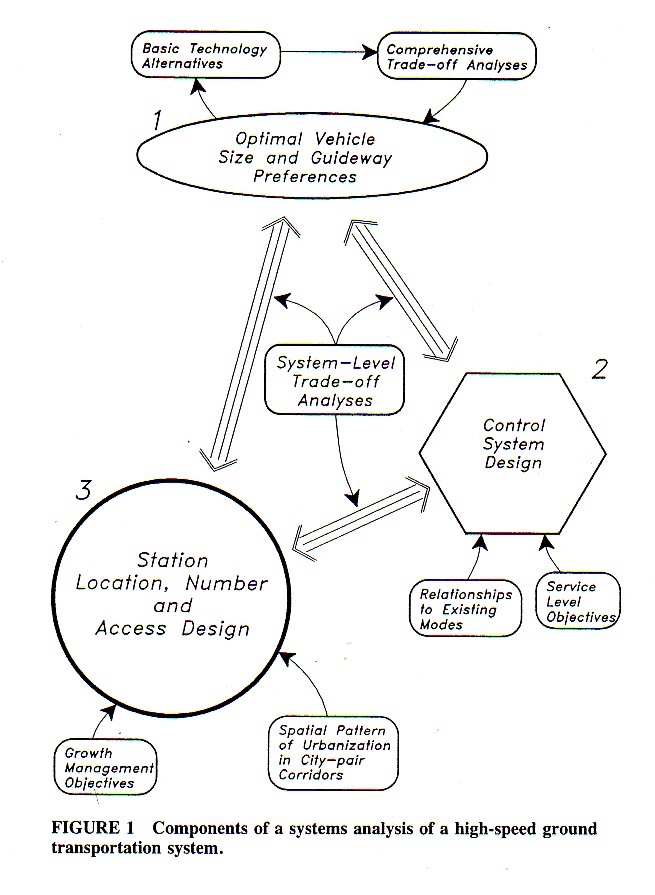
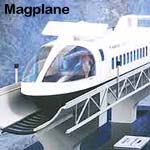
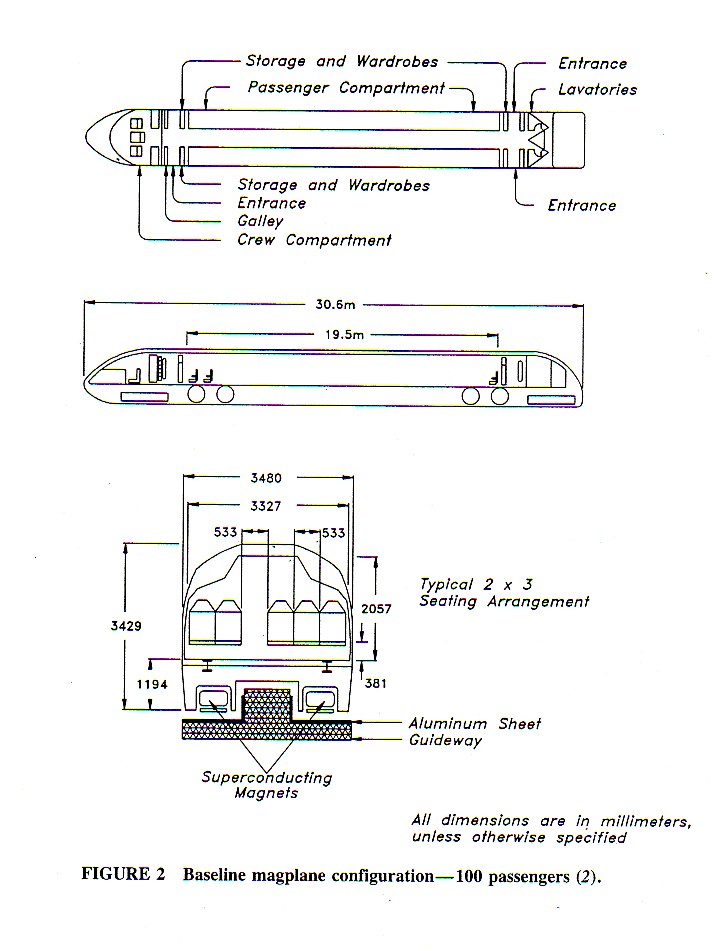









 Also,
see the Maglev2004 conference paper that describes the technical
attributes of the Magplane technology in more detail.
Also,
see the Maglev2004 conference paper that describes the technical
attributes of the Magplane technology in more detail.